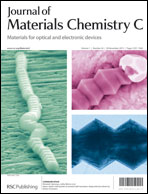An orange iridium(iii) complex with wide-bandwidth in electroluminescence for fabrication of high-quality white organic light-emitting diodes†
Abstract
A novel iridium(III) (pbi)2Ir(biq) with a strong orange emission at 573 nm was synthesized, which showed a high photoluminescence quantum yield (PLQY) of 45% in CH2Cl2 at 298 K. The quantum chemical calculations together with the photophysical properties indicated that the transition incorporation of 3MLCT (metal-to-ligand charge transfer), 3LLCT (ligand-to-ligand charge transfer) mixed with 3LC (ligand-centered 3π–π*) characters contributed to the emission of (pbi)2Ir(biq). Cyclic voltammetry (CV), thermogravimetric analysis (TGA) and differential scanning calorimetry (DSC) were then performed to investigate its electrochemical and thermal properties for fabrication of electroluminescent devices. Interestingly, complex (pbi)2Ir(biq) exhibited wide-bandwidth in electroluminescence (EL) of its orange electroluminescent devices, which made it effectively available to fabricate high-quality two-element white organic light-emitting diodes (WOLEDs). The resultant WOLED possessed a high current efficiency (ηc) of 22.1 cd A−1 and power efficiency (ηp) of 25.5 lm W−1 with a high color rendering index (CRI) of 80. Especially, the WOLED retained a favorable ηp of 10.9 lm W−1 and ηc of 16 cd A−1 at a high luminance of 1000 cd m−2. Moreover, it was worthwhile to note that this WOLED exhibited a qualified R9 of 13 and Duv of −0.0013, and these values together with the high CRI conformed to the required standard for lamp illumination of the ENERGY STAR.


 Please wait while we load your content...
Please wait while we load your content...